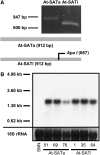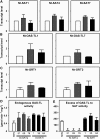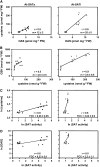Dominant-negative modification reveals the regulatory function of the multimeric cysteine synthase protein complex in transgenic tobacco
- PMID: 17293569
- PMCID: PMC1867341
- DOI: 10.1105/tpc.106.043125
Dominant-negative modification reveals the regulatory function of the multimeric cysteine synthase protein complex in transgenic tobacco
Abstract
Cys synthesis in plants constitutes the entry of reduced sulfur from assimilatory sulfate reduction into metabolism. The catalyzing enzymes serine acetyltransferase (SAT) and O-acetylserine (OAS) thiol lyase (OAS-TL) reversibly form the heterooligomeric Cys synthase complex (CSC). Dominant-negative mutation of the CSC showed the crucial function for the regulation of Cys biosynthesis in vivo. An Arabidopsis thaliana SAT was overexpressed in the cytosol of transgenic tobacco (Nicotiana tabacum) plants in either enzymatically active or inactive forms that were both shown to interact efficiently with endogenous tobacco OAS-TL proteins. Active SAT expression resulted in a 40-fold increase in SAT activity and strong increases in the reaction intermediate OAS as well as Cys, glutathione, Met, and total sulfur contents. However, inactive SAT expression produced much greater enhancing effects, including 30-fold increased Cys levels, attributable, apparently, to the competition of inactive transgenic SAT with endogenous tobacco SAT for binding to OAS-TL. Expression levels of tobacco SAT and OAS-TL remained unaffected. Flux control coefficients suggested that the accumulation of OAS and Cys in both types of transgenic plants was accomplished by different mechanisms. These data provide evidence that the CSC and its subcellular compartmentation play a crucial role in the control of Cys biosynthesis, a unique function for a plant metabolic protein complex.
Figures










Similar articles
-
Impact of sulfur starvation on cysteine biosynthesis in T-DNA mutants deficient for compartment-specific serine-acetyltransferase.Amino Acids. 2010 Oct;39(4):1029-42. doi: 10.1007/s00726-010-0580-9. Epub 2010 Apr 9. Amino Acids. 2010. PMID: 20379751
-
Enzymes of cysteine synthesis show extensive and conserved modifications patterns that include N(α)-terminal acetylation.Amino Acids. 2010 Oct;39(4):1077-86. doi: 10.1007/s00726-010-0694-0. Epub 2010 Jul 24. Amino Acids. 2010. PMID: 20658158
-
Functional analysis of the cysteine synthase protein complex from plants: structural, biochemical and regulatory properties.J Plant Physiol. 2006 Feb;163(3):273-86. doi: 10.1016/j.jplph.2005.11.013. Epub 2005 Dec 28. J Plant Physiol. 2006. PMID: 16386330 Review.
-
Mitochondrial cysteine synthase complex regulates O-acetylserine biosynthesis in plants.J Biol Chem. 2012 Aug 10;287(33):27941-7. doi: 10.1074/jbc.M112.372656. Epub 2012 Jun 22. J Biol Chem. 2012. PMID: 22730323 Free PMC article.
-
Molecular and biochemical analysis of serine acetyltransferase and cysteine synthase towards sulfur metabolic engineering in plants.Amino Acids. 2002;22(3):231-43. doi: 10.1007/s007260200011. Amino Acids. 2002. PMID: 12083067 Review.
Cited by
-
Functional characterization of the Serine acetyltransferase family genes uncovers the diversification and conservation of cysteine biosynthesis in tomato.Front Plant Sci. 2022 Sep 21;13:913856. doi: 10.3389/fpls.2022.913856. eCollection 2022. Front Plant Sci. 2022. PMID: 36212318 Free PMC article.
-
HYPK promotes the activity of the Nα-acetyltransferase A complex to determine proteostasis of nonAc-X2/N-degron-containing proteins.Sci Adv. 2022 Jun 17;8(24):eabn6153. doi: 10.1126/sciadv.abn6153. Epub 2022 Jun 15. Sci Adv. 2022. PMID: 35704578 Free PMC article.
-
Disruption of adenosine-5'-phosphosulfate kinase in Arabidopsis reduces levels of sulfated secondary metabolites.Plant Cell. 2009 Mar;21(3):910-27. doi: 10.1105/tpc.109.065581. Epub 2009 Mar 20. Plant Cell. 2009. PMID: 19304933 Free PMC article.
-
The Effect of Single and Multiple SERAT Mutants on Serine and Sulfur Metabolism.Front Plant Sci. 2018 May 28;9:702. doi: 10.3389/fpls.2018.00702. eCollection 2018. Front Plant Sci. 2018. PMID: 29892307 Free PMC article.
-
Heterologous expression analyses of rice OsCAS in Arabidopsis and in yeast provide evidence for its roles in cyanide detoxification rather than in cysteine synthesis in vivo.J Exp Bot. 2009;60(3):993-1008. doi: 10.1093/jxb/ern343. Epub 2009 Jan 30. J Exp Bot. 2009. PMID: 19181864 Free PMC article.
References
-
- Berkowitz, O., Wirtz, M., Wolf, A., Kuhlmann, J., and Hell, R. (2002). Use of biomolecular interaction analysis to elucidate the regulatory mechanism of the cysteine synthase complex from Arabidopsis thaliana. J. Biol. Chem. 277 30629–30634. - PubMed
-
- Blaszczyk, A., Brodzik, R., and Sirko, A. (1999). Increased resistance to oxidative stress in transgenic tobacco plants overexpressing bacterial serine acetyltransferase. Plant J. 20 237–243. - PubMed
-
- Bogdanova, N., Bork, C., and Hell, R. (1995). Cysteine biosynthesis in plants: Isolation and functional identification of a cDNA encoding a serine acetyltransferase from Arabidopsis thaliana. FEBS Lett. 358 43–47. - PubMed
-
- Bogdanova, N., and Hell, R. (1997). Cysteine synthesis in plants: Protein-protein interactions of serine acetyltransferase from Arabidopsis thaliana. Plant J. 11 251–262. - PubMed
-
- Boorer, K.J., Frommer, W.B., Bush, D.R., Kreman, M., Loo, D.D., and Wright, E.M. (1996). Kinetics and specificity of a H+/amino acid transporter from Arabidopsis thaliana. J. Biol. Chem. 271 2213–2220. - PubMed
Publication types
MeSH terms
Substances
Associated data
- Actions
- Actions
- Actions
- Actions
- Actions
- Actions
- Actions
- Actions
LinkOut - more resources
Full Text Sources
Molecular Biology Databases
Research Materials
Miscellaneous

